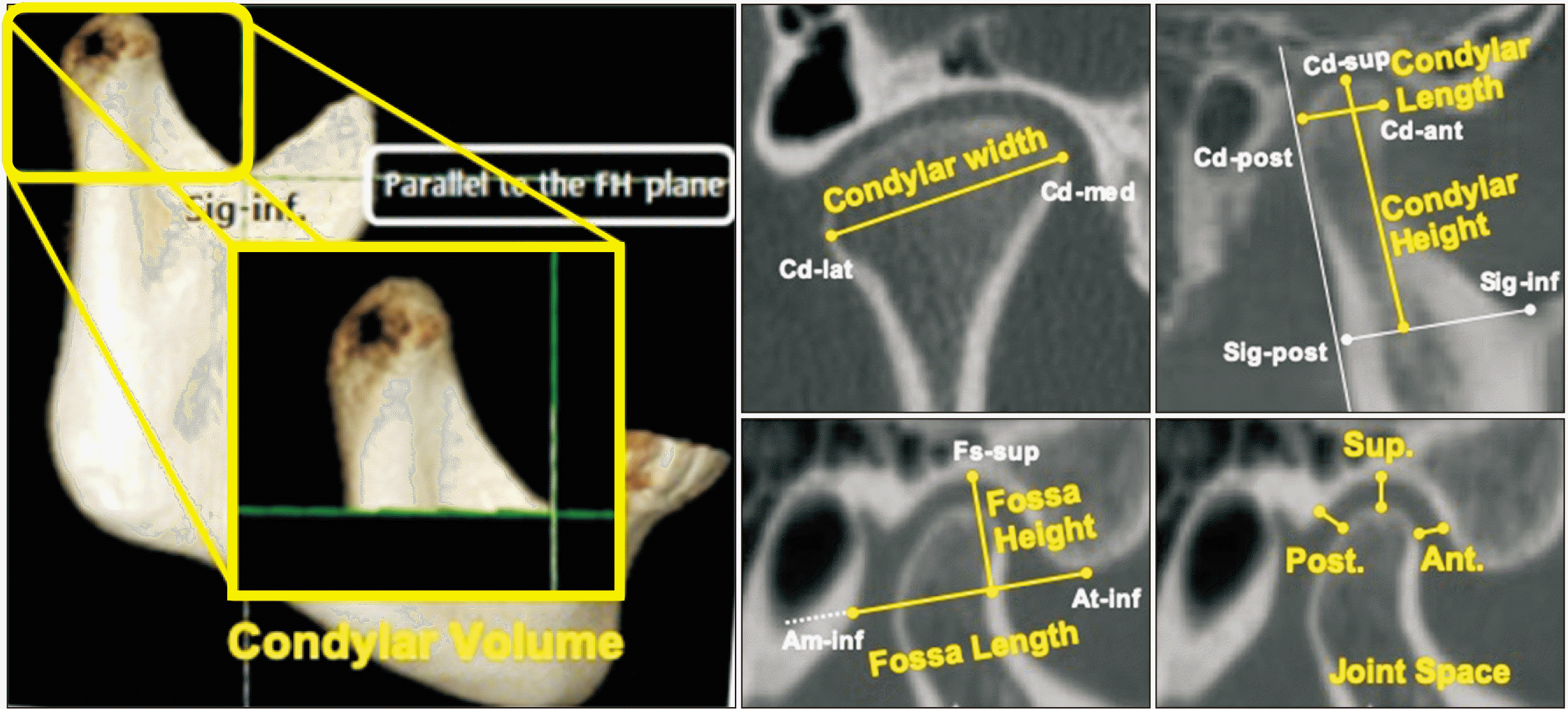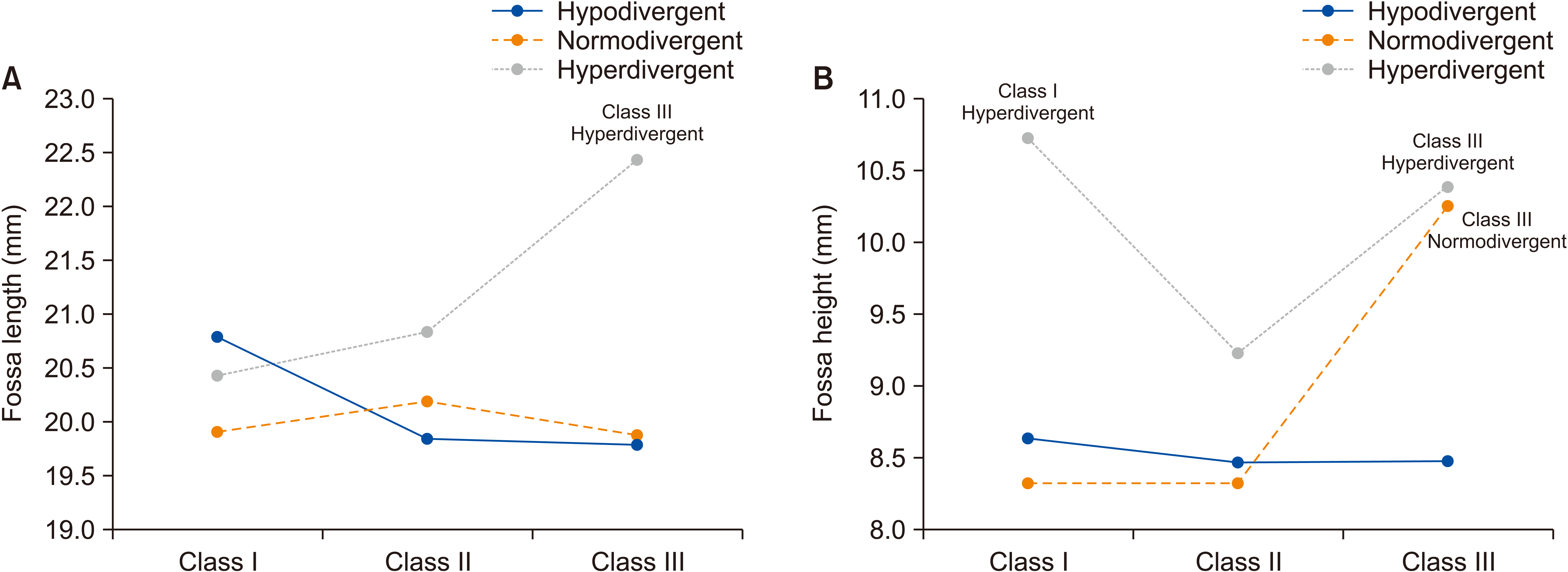1. Krisjane Z, Urtane I, Krumina G, Bieza A, Zepa K, Rogovska I. 2007; Condylar and mandibular morphological criteria in the 2D and 3D MSCT imaging for patients with Class II division 1 subdivision malocclusion. Stomatologija. 9:67–71. PMID:
17993738.

2. Tecco S, Saccucci M, Nucera R, Polimeni A, Pagnoni M, Cordasco G, et al. 2010; Condylar volume and surface in Caucasian young adult subjects. BMC Med Imaging. 10:28. DOI:
10.1186/1471-2342-10-28. PMID:
21194477. PMCID:
PMC3019198.



3. Katsavrias EG. 2006; Morphology of the temporomandibular joint in subjects with Class II Division 2 malocclusions. Am J Orthod Dentofacial Orthop. 129:470–8. DOI:
10.1016/j.ajodo.2005.01.018. PMID:
16627172.


4. Katsavrias EG, Halazonetis DJ. 2005; Condyle and fossa shape in Class II and Class III skeletal patterns: a morphometric tomographic study. Am J Orthod Dentofacial Orthop. 128:337–46. DOI:
10.1016/j.ajodo.2004.05.024. PMID:
16168330.


5. Krisjane Z, Urtane I, Krumina G, Zepa K. 2009; Three-dimensional evaluation of TMJ parameters in Class II and Class III patients. Stomatologija. 11:32–6. PMID:
19423969.

6. Park IY, Kim JH, Park YH. 2015; Three-dimensional cone-beam computed tomography based comparison of condylar position and morphology according to the vertical skeletal pattern. Korean J Orthod. 45:66–73. DOI:
10.4041/kjod.2015.45.2.66. PMID:
25798412. PMCID:
PMC4367133.



7. Saccucci M, D'Attilio M, Rodolfino D, Festa F, Polimeni A, Tecco S. 2012; Condylar volume and condylar area in class I, class II and class III young adult subjects. Head Face Med. 8:34. DOI:
10.1186/1746-160X-8-34. PMID:
23241136. PMCID:
PMC3558396.



8. Saccucci M, Polimeni A, Festa F, Tecco S. 2012; Do skeletal cephalometric characteristics correlate with condylar volume, surface and shape? A 3D analysis. Head Face Med. 8:15. DOI:
10.1186/1746-160X-8-15. PMID:
22587445. PMCID:
PMC3484012.



9. Vitral RW, Telles Cde S, Fraga MR, de Oliveira RS, Tanaka OM. 2004; Computed tomography evaluation of temporomandibular joint alterations in patients with class II division 1 subdivision malocclusions: condyle-fossa relationship. Am J Orthod Dentofacial Orthop. 126:48–52. DOI:
10.1016/j.ajodo.2003.06.012. PMID:
15224058.


10. Kurita H, Uehara S, Yokochi M, Nakatsuka A, Kobayashi H, Kurashina K. 2006; A long-term follow-up study of radiographically evident degenerative changes in the temporomandibular joint with different conditions of disk displacement. Int J Oral Maxillofac Surg. 35:49–54. DOI:
10.1016/j.ijom.2005.04.004. PMID:
15961278.


11. Sümbüllü MA, Cağlayan F, Akgül HM, Yilmaz AB. 2012; Radiological examination of the articular eminence morphology using cone beam CT. Dentomaxillofac Radiol. 41:234–40. DOI:
10.1259/dmfr/24780643. PMID:
22074873. PMCID:
PMC3520296.



12. Yamada K, Tsuruta A, Hanada K, Hayashi T. 2004; Morphology of the articular eminence in temporomandibular joints and condylar bone change. J Oral Rehabil. 31:438–44. DOI:
10.1111/j.1365-2842.2004.01255.x. PMID:
15140169.

13. Hasegawa H, Saitoh I, Nakakura-Ohshima K, Shigeta K, Yoshihara T, Suenaga S, et al. 2011; Condylar shape in relation to anterior disk displacement in juvenile females. Cranio. 29:100–10. DOI:
10.1179/crn.2011.018. PMID:
21661584.

14. Paknahad M, Shahidi S, Akhlaghian M, Abolvardi M. 2016; Is mandibular fossa morphology and articular eminence inclination associated with temporomandibular dysfunction? J Dent (Shiraz). 17:134–41. PMID:
27284559. PMCID:
PMC4885671.


15. Weinmann JP, Sicher H. 1947. Bone and bones: fundamentals of bone biology. Mosby;St. Louis:
16. Mupparapu M, Chow I, Uppal A. 2011; Hard tissue structural changes in TMJ morphology prior to orthodontic therapy: a complex motion tomographic study. Quintessence Int. 42:427–34. PMID:
21519564.

17. Al-Riyami S, Moles DR, Cunningham SJ. 2009; Orthognathic treatment and temporomandibular disorders: a systematic review. Part 1. A new quality-assessment technique and analysis of study characteristics and classifications. Am J Orthod Dentofacial Orthop. 136:624.e1–15. discussion 624–5. DOI:
10.1016/j.ajodo.2009.02.021. PMID:
19892268.
18. Chae JM, Park JH, Tai K, Mizutani K, Uzuka S, Miyashita W, et al. 2020; Evaluation of condyle-fossa relationships in adolescents with various skeletal patterns using cone-beam computed tomography. Angle Orthod. 90:224–32. DOI:
10.2319/052919-369.1. PMID:
31638857.


20. Petersson A. 2010; What you can and cannot see in TMJ imaging--an overview related to the RDC/TMD diagnostic system. J Oral Rehabil. 37:771–8. DOI:
10.1111/j.1365-2842.2010.02108.x. PMID:
20492436.

21. Nur RB, Çakan DG, Arun T. 2016; Evaluation of facial hard and soft tissue asymmetry using cone-beam computed tomography. Am J Orthod Dentofacial Orthop. 149:225–37. DOI:
10.1016/j.ajodo.2015.07.038. PMID:
26827979.


22. Kim SJ, Kim KH, Yu HS, Baik HS. 2014; Dentoalveolar compensation according to skeletal discrepancy and overjet in skeletal Class III patients. Am J Orthod Dentofacial Orthop. 145:317–24. DOI:
10.1016/j.ajodo.2013.11.014. PMID:
24582023.


23. Kim JH, Gansukh O, Amarsaikhan B, Lee SJ, Kim TW. 2011; Comparison of cephalometric norms between Mongolian and Korean adults with normal occlusions and well-balanced profiles. Korean J Orthod. 41:42–50. DOI:
10.4041/kjod.2011.41.1.42.

25. Hilgers ML, Scarfe WC, Scheetz JP, Farman AG. 2005; Accuracy of linear temporomandibular joint measurements with cone beam computed tomography and digital cephalometric radiography. Am J Orthod Dentofacial Orthop. 128:803–11. DOI:
10.1016/j.ajodo.2005.08.034. PMID:
16360924.


26. Bjork A. 1963; Variations in the growth pattern of the human mandible: longitudinal radiographic study by the implant method. J Dent Res. 42Pt 2:400–11. DOI:
10.1177/00220345630420014701. PMID:
13971295.

28. Burke G, Major P, Glover K, Prasad N. 1998; Correlations between condylar characteristics and facial morphology in Class II preadolescent patients. Am J Orthod Dentofacial Orthop. 114:328–36. DOI:
10.1016/S0889-5406(98)70216-1. PMID:
9743139.


30. Arnett GW, Gunson MJ. 2004; Facial planning for orthodontists and oral surgeons. Am J Orthod Dentofacial Orthop. 126:290–5. DOI:
10.1016/j.ajodo.2004.06.006. PMID:
15356488.






 PDF
PDF Citation
Citation Print
Print





 XML Download
XML Download